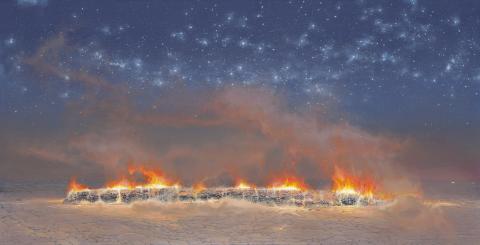CAPRICORN HAZE, c. 2001
TIM STORRIER
synthetic polymer paint on linen
124.0 x 244.0 cm
signed lower right: Storrier
Queensland Art Brokering
Private collection, Sydney
Company collection, Melbourne
Tim Storrier’s distinctive ‘Point to Point’ series began in the early 1980s while experimenting with fire. Setting alight a suspended rope typically against the backdrop of the Australian horizon, Storrier would observe and depict the mesmerising flames, capturing the moments before the burning rope is consumed by the fire. ‘It is a paradoxical moment visually: the fire is at its most brilliant, but the rope is already dissolving and slackening under the assault of the flames. It is this temporal ambiguity, the moment before illumination and annihilation, which Storrier subsequently took as his subject matter in work after work.’1 Exploring this moment of annihilation, Storrier began to replace the ropes with tree logs. Larger in size and burning more fiercely than the ropes, the burning logs are suggestive of destruction and natural disasters such as bushfires that can ravage the countryside in an uncontrollable frenzy.
In Capricorn Haze, c.2001 Storrier demonstrates the sublime albeit harsh beauty of his landscapes, a visual characteristic that is synonymous with the representation of the Australian outback. The unforgiving terrain, the brilliant light of the sky whether it be day or night, and the sheer vastness of space are all quintessential elements of his idiosyncratic desertscapes. In the picture on offer, the dusty cracked earth is completely desiccated and the barren land stretches for miles, and yet despite the absence of vegetation or any other life form, there is a haunting beauty in the austere surrounds. The celestial sky is illuminated by the stars, suggesting a spiritual beauty and an infinite world beyond ours. The distant horizon extends across the canvas but is largely obscured by the flaming log and the haze of smoke. Burning fiercely, the log is almost at the point of obliteration, utterly consumed by the fire and serving as a constant visceral reminder of mortality and the brutal power of nature.
Storrier’s atmospheric and mesmerising landscapes, such as Capricorn Haze evoke a variety of emotions, from despair and fear to hope and optimism. Despite the vulnerability of mankind and that our fragile creations are at the mercy of the elements, it is those same forces of nature that provide the cycle of renewal after complete devastation.
1. Lumby, C., Tim Storrier: The Art of the Outsider, Craftsman House, Sydney, 2000, p. 51
CASSI YOUNG
